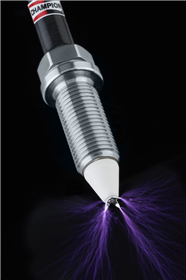
The Corona technology is being developed as a possible replacement to the spark plugs that we find for most ignition technologies of the cars around today. This technology has the capability of improving gas mileage by up to 10%. Instead of using a single spark, the technology of spark plugs, the ACIS corona uses multiple plasma jets.
The idea for this technology has been around since 1969, when GM had a patent on it. In recent years, the corona has made major strides and the possibility of it appearing in the next generation of cars continues to become more and more practical. The new ignition technology is made up of two parts. The first part is very similar to the spark plug; it is made up of top pieces. The top half is the inductor and the bottom half is where the plasma is fired. The second part is the controller that converts the action of turning the key into a signal to start the technology.
When the corona is turned on, it produces an electrical field that excites the air and fuel mix. This gets the gas to extend into the combustion chamber and it ignites the charge. The whole process takes a few nanoseconds, which is a considerable difference from the spark plug process, which required about 70 nanoseconds.
When combined with other technologies that are related to the corona, the technology has the potential to improve fuel economy by up to 30%.
This new approach to ignition is not expected to hit the market for another 5 years, but it is currently being tested in many cars all over Europe.
Technologies like this will be key for companies to reach the CAFE standards set for 2025 at 54.5mpg. If minor changes like this and the aluminum body for example continue to arise, companies won’t have to consider alternative sources of energy as strongly as they are now.
Source:
http://www.federalmogul.com/en-US/Media/Documents/CoronaIgnitionSystem_MTZ_62013.pdf
No doubt this technology, once put in the market, is capable of great things. What interests me more is that OEMs used to design most of the parts and provides the technology. OEMs used to be the leader but now it seems that suppliers are stepping up. This is beneficiary for both sides and I think this can accelerate the progress of advance in auto industry.
Advanced ignition technology can not only help to improve fuel economy, but also overall ignition stability. During our visit to Federal Mogul, the executive showed us that future ignitor can operate even in extremely low temperature. This means that when people try to start their cars during winter, they no longer need to attempt several times before actually start their cars.
I like Jier’s point. I think a system where everybody is actively trying to come with new technology instead of just responding to needs or orders can be very helpful. It reminds me of the people at Federal Mogul who travel around to work with OEMs and are responsible for some of their most important advancements
I remember our visit at Federal Mogul and seeing one of these in a development room. The engineer we spoke with mentioned that this technology would be more expensive that the typical spark plug to develop, and that that was part of the reason they have not made a big push to get them in new cars. If these can be manufactured at a lower price I think they will be a very effective part in reducing fuel economy.
I think we asked this at multiple of the tier 1 suppliers we visited, but about what percentage of the research done at a company like Federal Mogul is because an OEM asks for it, and how much is Federal Mogul’s own initiative?
The suppliers as suppliers of technology is indeed something we saw at each firm we visited. That was true even at Metalsa, where what we saw was processing technology but where in other plants they help their customers design frames.
I’ve tried to go back through 20 years of PACE Award finalists. Some are OEM-initiated technologies, but that’s a reflection that suppliers have the technology, not the OEMs. Co-development is standard, because there’s no such thing as a generic car.
The various gain figures – 10% vs 30% – depend on whether the engine geometry is redesigned to take advantage of the corona. Now 10% is a big number, 30% is huge. However that’s a big bet, because if you design your car’s drivetrain around the ACIS [and make weight choices elsewhere based on expected efficiency gains] it really, really has to work. So as noted it will be a couple years before it’s on a production vehicle, and that one may be a small volume project.
One bottom line: the ICE continues to improve, lowering the relative benefits of alternative powertrains such as battery electric vehicles.
Yes, but even at 54.5 mpg, gas guzzlers aren’t as efficient as electrics and they still rely on a single point of failure: oil prices. Companies and countries would be foolish to put all their eggs into a volatile commodity basket.